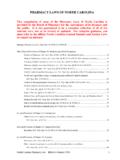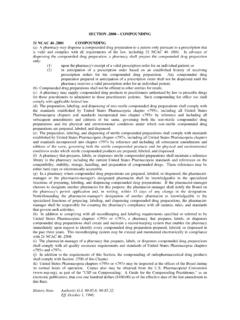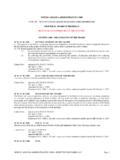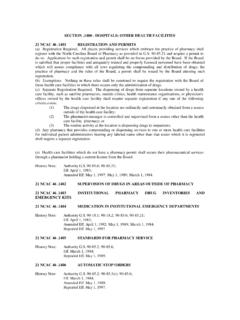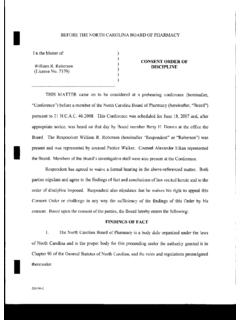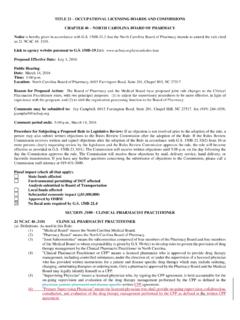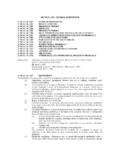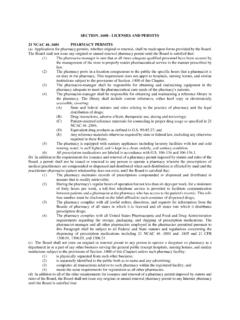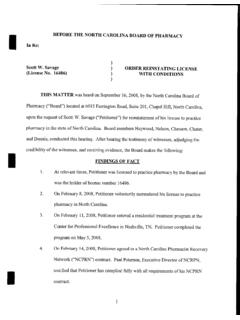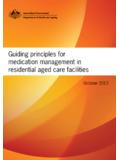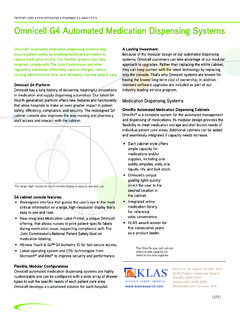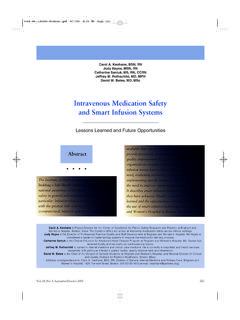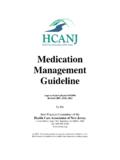Transcription of Pharmacist Workload and Pharmacy Characteristics ...
1 ORIGINAL ARTICLE. Pharmacist Workload and Pharmacy Characteristics associated With the Dispensing of Potentially Clinically Important Drug-Drug Interactions Daniel C. Malone, PhD,* Jacob Abarca, PharmD, MS, Grant H. Skrepnek, PhD,*. John E. Murphy, PharmD,* Edward P. Armstrong, PharmD,* Amy J. Grizzle, PharmD,*. Rick A. Rehfeld, BS,* and Raymond L. Woosley, PhD, MD . Workload , use of specific automation, and dispensing software Background: Drug-drug interactions (DDIs) are preventable med- programs providing alerts and clinical information. ical errors, yet exposure to DDIs continues despite systems that are designed to prevent such exposures. The purpose of this study was Key Words: drug-drug interactions, medication safety, Workload , to examine Pharmacy Characteristics that may be associated with Pharmacist , medical errors dispensed potential DDIs. (Med Care 2007;45: 456 462).
2 Methods: This study combined survey data from community phar- macies in 18 metropolitan statistical areas with Pharmacy claims submitted to 4 Pharmacy benefit managers (PBMs) over a 3-month period from January 1, 2003 to March 31, 2003. Pharmacy charac- teristics of interest included prescription volume, the number of full-time equivalent pharmacists and Pharmacy staff, computer soft- T he Institute of Medicine's reports on the quality of health care in the United States have highlighted the importance of reducing medical 4 Drug-drug interactions (DDIs). ware programs, and the ability to modify those programs with are a subset of preventable errors; pharmacists are in a unique respect to DDI alerts, the use of technologies to assist in receiving, position to identify and intervene. Commonly, within com- filling and dispensing medication orders, and prescription volume.
3 Munity pharmacies, computer software programs assist phar- The dependent variable in this study was the rate of dispensed macists in identifying DDIs of potential clinical importance medications that may interact. (hereafter termed potential DDIs). Software algorithms that Results: A total of 672 pharmacies were included in the analysis. On identify potential interactions are often based on rules devel- average ( SD), the respondents filled 1375 691 prescriptions per oped by proprietary companies such as First DataBank and week, submitted 17,948 23,889 Pharmacy claims to the partici- Medi-Span; these algorithms may be modified by pharmacists pating PBMs, had full-time equivalent pharmacists per or Pharmacy software developers. In the normal process of hour open, and 545 (81%) were affiliated with a chain drug store entering prescription information into computer systems, organization.
4 Factors significantly related to an increased risk of alerts are generated when 2 medications in a patient's profile dispensing a potential DDI included Pharmacist Workload (odds may interact. Previous studies have found that some pharma- ratio OR ; 95% confidence interval CI ), phar- cists have become desensitized to the alerts and spend little macy staffing (OR ; 95% CI: ), and various technol- time evaluating ,6 As a result of decreasing manpow- ogies (eg, sophisticated telephone systems, internet receipt of orders, er,7 pharmacists may be required to process prescriptions at and refill requests) that assist with order processing, and the ability higher rates, thus reducing their ability to adequately assess to modify DDI alert-screening sensitivity and detailed pharmaco- potential DDIs. logical information about DDIs. Few studies have been conducted to identify Pharmacy Conclusions: This study found that there was an increase in the risk factors that might be related to higher rates of patient expo- of dispensing a potential DDI with higher Pharmacist and Pharmacy sure to potential DDIs.
5 The purpose of this study was to examine Pharmacy operational Characteristics and rates of dispensed potential DDIs in community pharmacies. A DDI. From the *College of Pharmacy , University of Arizona, Tucson; Wellpoint occurs when 1 drug causes the modification of another drug, NextRx, Tucson, Arizona; and The Critical Path Institute, Tucson, resulting in a physiological change in response to the inter- Arizona. Supported by an Agency for Healthcare Research and Quality (AHRQ) The administration of 2 medications that may interact Centers for Education and Research on Therapeutics cooperative agree- does not always manifest as a true DDI. Some change in ment (grant U18 HS10385-03 ( ). physiological processes or other activity must occur for a true Reprints: Daniel C. Malone, PhD, College of Pharmacy , University of interaction to be present. Consequently, this study refers to Arizona, Box 210202, Tucson, AZ 85721.)
6 E-mail: Pharmacy claims data indicating that 2 medications obtained Copyright 2007 by Lippincott Williams & Wilkins by the same patient could lead to an interaction. We refer to ISSN: 0025-7079/07/4505-0456 this as a dispensed potential DDI.. 456 Medical Care Volume 45, Number 5, May 2007. Medical Care Volume 45, Number 5, May 2007 Pharmacist Workload and Pharmacy Characteristics METHODS represented in the study were contacted and asked to provide This study examines the relationship between the rate a letter of support for the study. Fifteen chain organizations of dispensed potential DDIs and operational Characteristics in provided a letter of support that was sent to 555 pharmacies. community pharmacies. Pharmacy claims data submitted to 4. large Pharmacy benefit managers (PBMs) were combined PBM Data with survey data from community pharmacies. Participating For survey respondents, the Pharmacy NCPDP num- PBMs represented approximately 120 million covered lives bers were sent to the participating PBMs to determine the in the United States at the time of this study.
7 The research was number of potential DDIs dispensed at that Pharmacy . Twen- approved by the University of Arizona Human Subjects ty-five DDIs of interest based on work previously conducted Protection Program. by the investigators were ,12 The participating PBMs ran a standard DDI algorithm developed by the re- Pharmacy Sample search team for Pharmacy claims submitted from January 1, A postal survey was used to obtain data from commu- 2003 to March 31, 2003. Results from the algorithm were nity pharmacies in 18 distinct metropolitan statistical areas provided to the research team and aggregated across the (MSAs) or consolidated MSAs (CMSAs) in the United States PBMs. Data were provided at the Pharmacy level, including (Atlanta, GA; Austin, TX; Baltimore, MD; Chicago, IL; the number of dispensed potential DDIs and total prescription Dallas-Ft. Worth, TX; Denver, CO; Detroit, MI; Houston, claim volume over the 3-month period of interest.)
8 TX; Los Angeles, CA; Miami, FL; Minneapolis, MN; New York/New Jersey/Long Island; Philadelphia, PA; Phoenix, Data Analysis AZ; San Diego, CA; Seattle, WA; St. Louis, MO; and In the data analysis we first describe the sample in Washington, DC). These MSAs were selected based on the terms of Pharmacy personnel and operational Characteristics . theory that pharmacies in large metropolitan areas are more Data from the surveys were examined for out-of-range values likely to have a greater proportion of their prescriptions paid and missing data. Analysis of Pharmacy Characteristics mea- for by third-party payers than pharmacies located in rural sured on a continuous scale was conducted using descriptive areas. In addition, costs of obtaining the Pharmacy sample statistics. Chain pharmacies were defined as 4 or more phar- and survey mailing expense were factors in limiting the study macies under the same ownership.
9 For questions concerning to these MSAs. A list of 18,596 community pharmacies with the use of technology the response choices of, Yes, No, . a valid National Council for Prescription Drug Programs or Not sure were collapsed into 2 categories (ie, yes or (NCPDP) Inc. identification number in these 18 areas was no/not sure). The presence of (1) a tablet/capsule counting obtained from American Medical Information, a proprietary machine, (2) Baker cell or similar vial filling device, (3). medical marketing company. The NCPDP number for these computerized control of an automated filling device, (4) a community pharmacies was then sent to the participating filling device that automatically attaches a label to a vial/. PBMs to select pharmacies with at least 500 prescription package, and (5) a bar code scanner for medication verifica- claims submitted during June and July of 2003, which re- tion was transformed from yes/no to an ordinal scale ranging duced the eligible sample to 9523 pharmacies.
10 A stratified from 0 (no technology) to 5 (all 5 types of technology). random sample of 3000 community pharmacies was selected Additional detail on the distribution of technologies in these from this list. Community pharmacies were stratified by pharmacies is reported MSA/CMSA with a minimum of 100 pharmacies selected The next step in the analysis was to create summary from each area to ensure adequate representation. measures of prescription volume, adjusted for Pharmacist staffing. This was done by calculating a ratio of the reported Pharmacy Survey prescriptions processed per week divided by the hours the A survey instrument specific to this study was devel- Pharmacy was open per week. The product was then divided by oped, tested in a focus group, piloted, and revised based upon the total number of Pharmacist hours per week. A similar ratio the comments ,10 The final survey instrument con- was created by dividing prescriptions per hour by the sum of all tained 34 items and covered the following 4 topics: (1) Pharmacy staffing ( pharmacists , technicians, interns, and non- Workload issues, (2) use of technology in prescription pro- technician supportive personnel) hours per week.
